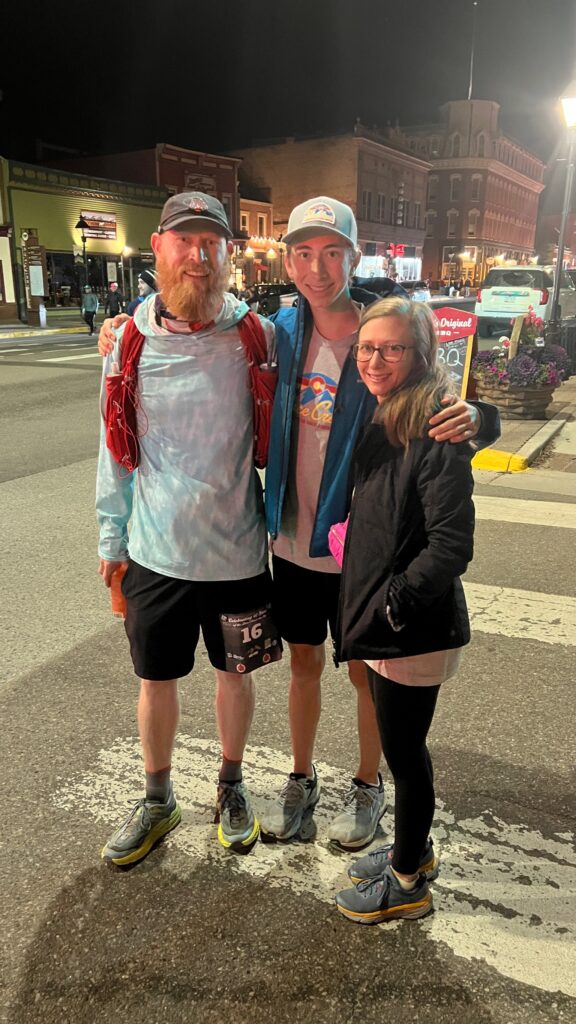
The starting line was abuzz with excitement as the clock approached 4:00 am. Every individual gathered for this race had earned their spot and had been training for nearly a year or even longer. You don’t casually stroll up to the starting line of one of the most challenging 100-mile races. Unlike my 50-mile race here in Leadville a few years ago, I didn’t experience imposter syndrome. At the beginning of this monumental race, I felt a strong sense of belonging and had no doubt that I would complete it. I was fully aware that this would be one of the most physically demanding feats of my entire life.

As the clock crept closer to the start time, Ken Chlouber, the founder of the Leadville Trail 100 said with conviction, “You’re better than you think you are. You can do more than you think you can.” He followed that up with, “Dig deep into that inexhaustible well of grit, guts and determination. If all else fails, remember this one word – LEADVILLE.” This is classic Ken. It doesn’t seem as powerful in black and white text as it did hearing this incredible man with a storied past say it.
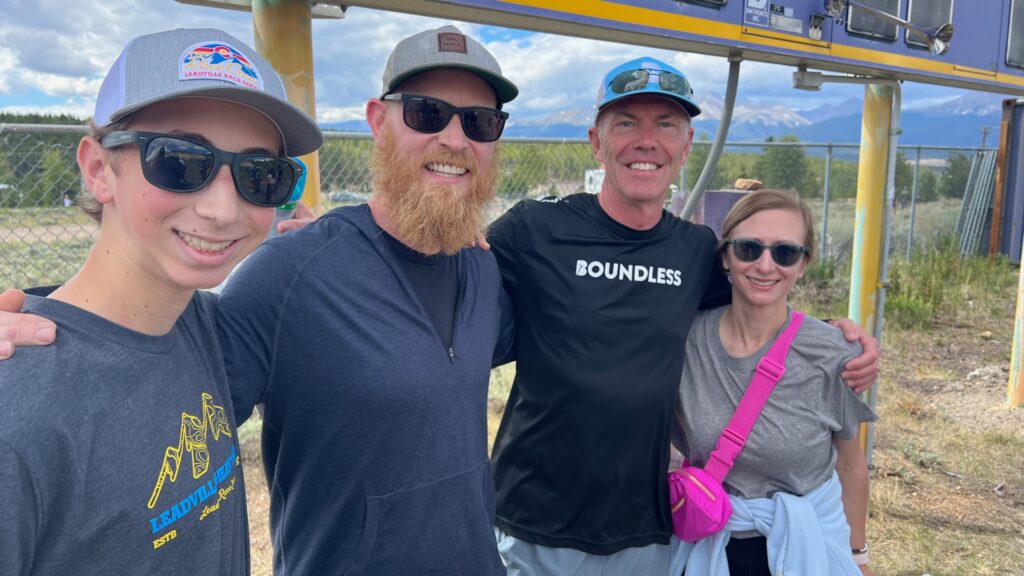
Around this time, amid the confusion of 800 people lining up in the dark, my coach (Scott Jordan) found me. Since he knew that I had a tendency to start to fast, he suggested we run together the first few miles. Before long, the national anthem was being sung and then seemingly without much warning Ken fired his shotgun and we were literally off to the races.

My pulse is normally ridiculously low, but not right now. My heart is racing like I can’t remember as the pack of runners begins to steadily move out of downtown Leadville away from Harrison Avenue on Sixth Street. It doesn’t take long to get to the first hill – with nearly 18,000 feet of elevation gain expected over the course, there certainly would not be a shortage of hills!
Before long, we were on dirt trails and the pavement and crowds of Leadville seemed a world away. At a brief five miles outside of Leadville, we were approaching the Sugarloaf Dam end of the beautiful Turquoise Lake. This high-elevation lake is where the mountains of the Continental Divide drain into the Arkansas River Basin, which then empties water into Turquoise Lake. It is named due to the nearby turquoise-colored mineral deposits – the reminder that we are near mining is never far off. At this point, I hit a bit of a traffic jam on the single-track section. That’s OK though – I used the time to run at a steady pace and enjoy the first bit of dawn. It takes a while, but the congo line of runners picks their way all the way around the lake, which is a 6 or so mile section.
Just as the sun was peeking above the mountains, I exited the trail on the west end of the lake and hit the pavement headed up to the May Queen Aid Station at around 2 hours and 15 minutes into the race. The words of my coach echoed in my ear – never more than a minute at these aid stations or it adds up. I was in-and-out within about 30 seconds with my liquids topped off and ready to go!
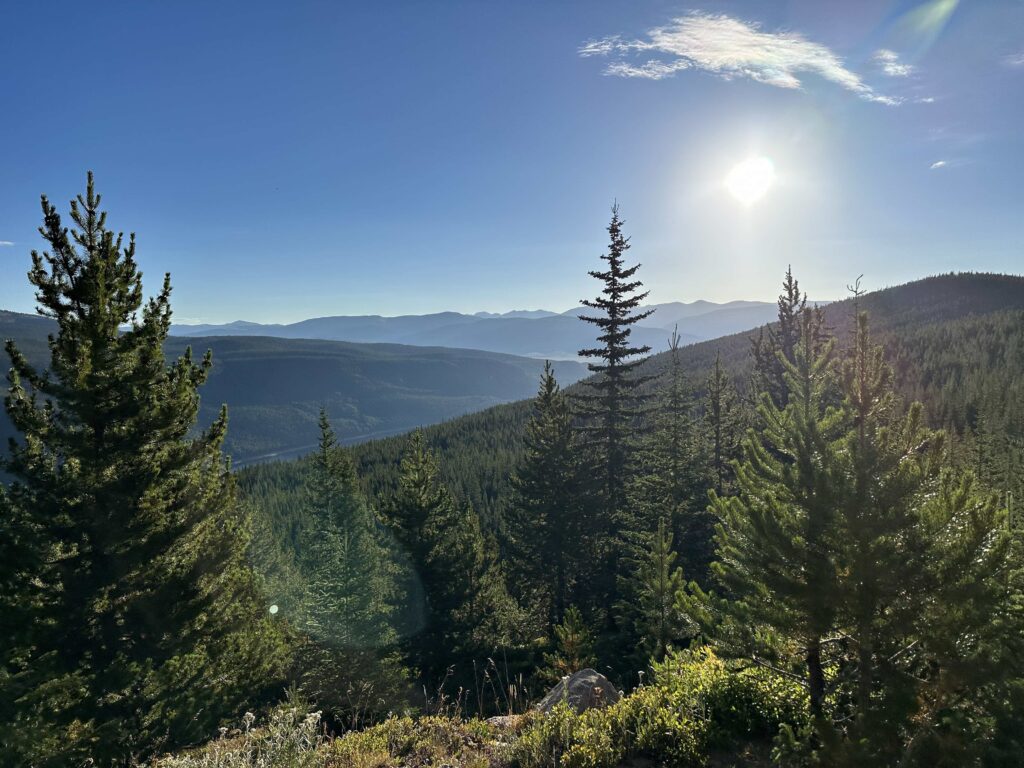
As soon as I headed away from the aid station, I hit the Colorado Trail. This technical, uphill section is filled with loose gravel, boulders, and roots. The traffic jam was mostly gone now, and it was time to keep the pace up – this was the first challenging section. I moved through this section pretty quickly, but patience is paramount – this isn’t a half-marathon or marathon. When the trail got too technical or was really steep, I would stop and power-hike a bit. After a while, I make a right on Hagerman Pass Road – the gradient here is doable to run so I do. Looking back below me I see some beautiful views of Turquoise Lake below me and this wide gravel road makes for easy running after The Colorado Trail. I can see high-tension powerlines in the distance, which can only mean one thing – we are about to make a decent climb up to Sugarloaf Pass – the top of the infamous Powerline. I’ll have to climb Powerline at some point, but that will be much later in the race. Now, I get to descend it.
On this section, I run into another Boundless Coach and friend Brad. We run the descent together both focused on getting to Outward Bound in a reasonable time. The descent is both steep and uneven – the trail is filled with rocks, erosion, and ditches. I want to make good time, but do not want to destroy my quads this early. Steady. Although I slide a few times, I am thankful that I don’t wipeout. I see two or three people take pretty nast spills as we descent the approximately 1,500’ to a paved road. I am thankful that Outward Bound (next aid station) is near and can’t wait to see my family and friends after nearly 4 ½ hours on the trail. I’m nearly a mountainous trail marathon in, but I’m just getting started.
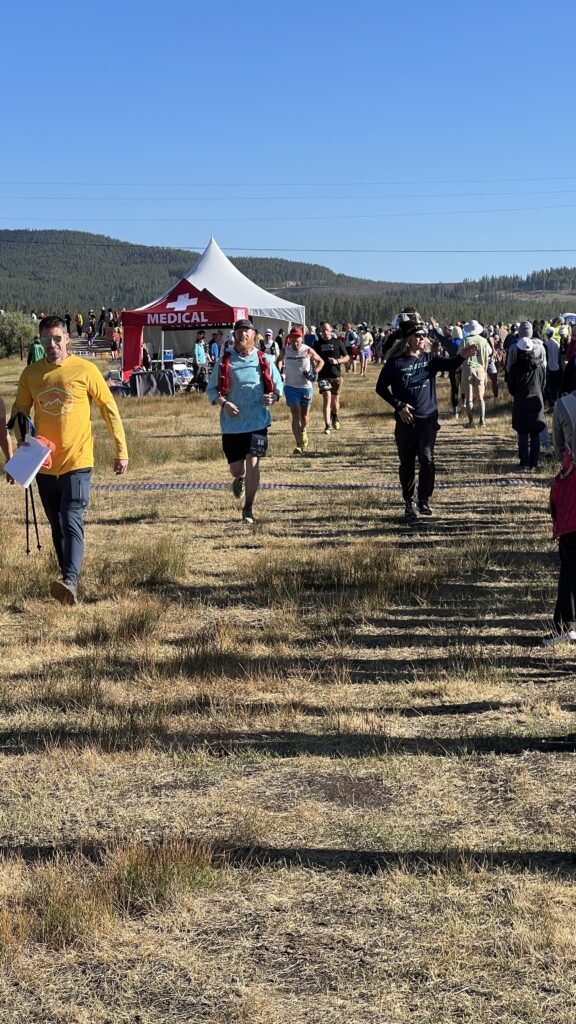
Running into Outward Bound, I see my son (John Harrison) and one of my pacers (John S.) waiting for me. They go crazy when they see me, and it gives my spirits a big lift. I run across the field and pass the official checkpoint and they lead me to my crew. Keeping in the mentality of Nascar Pit Crew, they have me back out in the course in a minute or so.
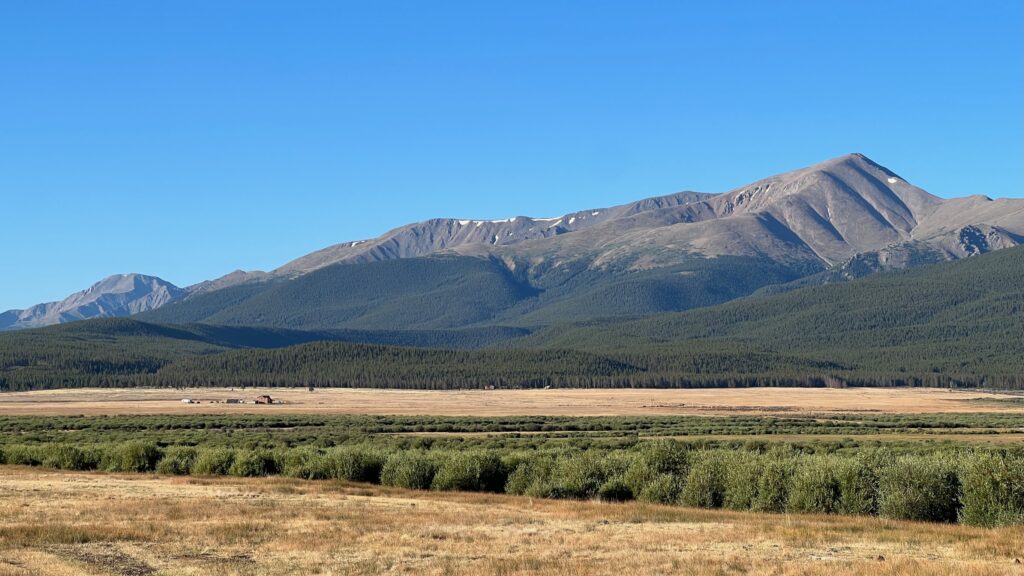
Leaving the aid station, I ran across a literal pasture – it is imperative to keep focused or a twisted ankle could end the day early. This is a bit of a challenge as I am trying to enjoy the scenery of Mount Elbert and Mount Massive – two of Colorado’s highest peaks – which tower around me. After running across the field, there is a paved section followed by a jeep road. This is a relatively easy, slightly uphill section of around 6 miles. I reach the next aid station (Half Pipe – almost 30 miles in) approximately one hour later and top off my bottles.
I have run this next section (up Mount Elbert) before and know its about to get real. Half Pipe to Twin Lakes is a gnarly section of trail filled with single-track through the woods and quite a few decent climbs. The key here is to keep a decent pace and keep your legs fresh for Hope Pass. The sun is beating down on me for this entire nine-mile section and it will end up taking me about two hours. I am pretty disappointed that a listed aid station (Mount Elbert) is missing and there is no where to refill my water bottles – I deal with it though. Finally, the climbs are over and it is time for the quad-crushing descent into Twin Lakes. As I run into Twin Lakes, I realize my time is pretty good 7.5 hours and through with almost 40 miles of tough terrain. All-in-all I’ll take it!
In Twin Lakes, I took a bit longer at the aid station to make sure I had everything I needed – thankfully I did – without the essential items that I was checking I would likely have DNF’d. I made sure I had my trekking poles, headlamp (didn’t think I would need it, it was only 11:30 am after all!), rain gear, plenty of nutrition, extra water, and a water filter.
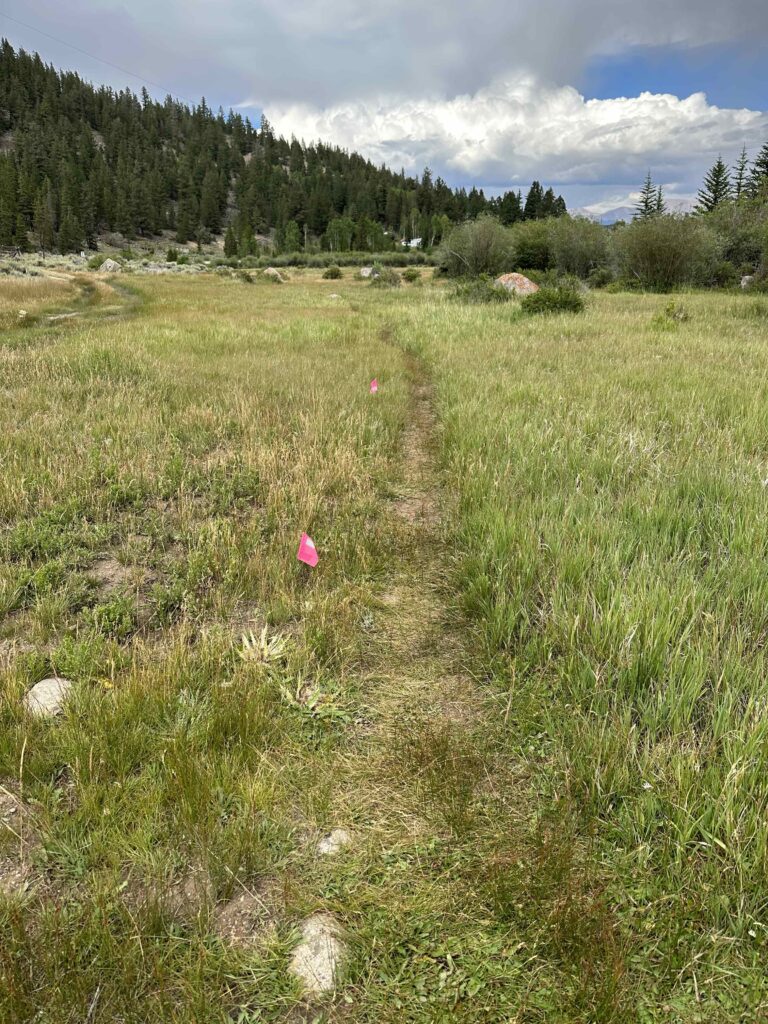
Leaving the Twin Lakes aid station, there is an easy run across a meadow. However, even though it is easy now, I clearly remember advice from many people who had to top out on this next section – the 25 +/- miles over Hope Pass to Winfield and back to Twin Lakes is enough to make grown men cry. This section is filled with challenging terrain and you are fully exposed to the elements. Even if you don’t give up on this section, you can easily ‘time out.’ In fact, this would happen to multiple friends and teammates before Hope Pass was done for us.
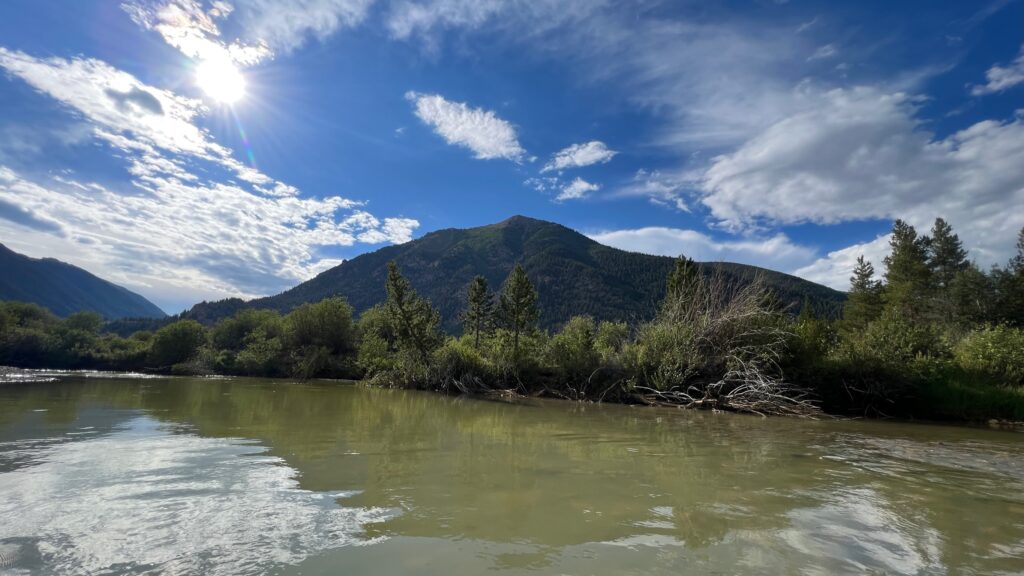
After crossing the meadow, you come to a cold, mountain river. There is a rope guideline across the river, which is there for safety reasons. It is fairly easy to navigate the river with the guideline, but impossible to keep your feet dry – that’s ok though – the snow-melt, cold water feels great and refreshing on my tore up feet.
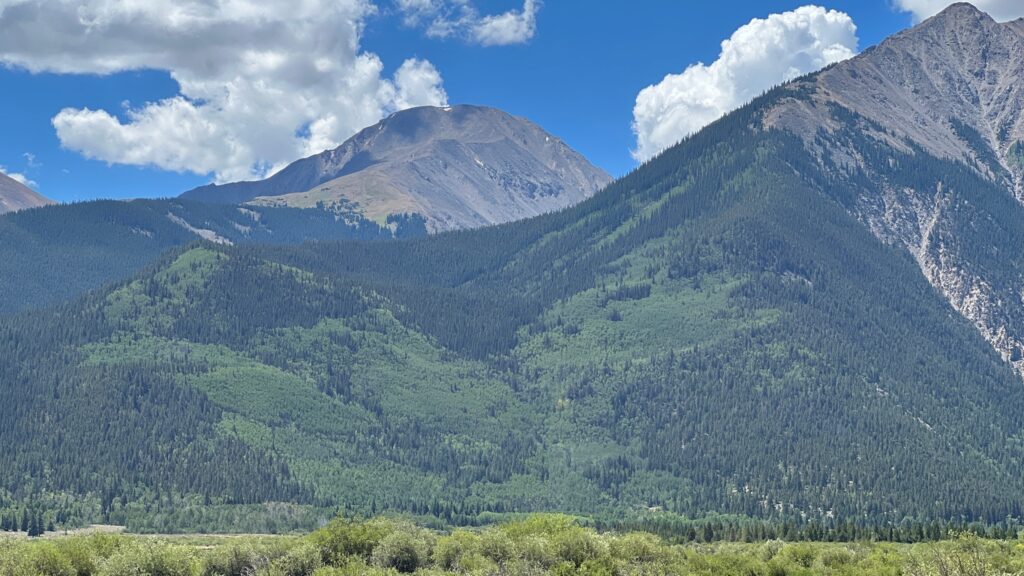
With the famous pass looming above me, it’s time to start climbing. This is a good time to mention that when you are climbing a 3,400’ vertical pass, no one is actually running. Sure, you may run a hundred level or easy gradient yards here or there, but don’t get the idea that we are just charging up the side of the mountain – that is humanly impossible. Even David Goggins, Lance Armstrong, and the winner of the race have to respect the sheer size of this mountain.
As I power-hike up the mountain, nausea starts to hit me. I feel like I’m moving way too slow and wonder why I am doing this. Even though I am regularly vomiting, I am thankful that my vomit doesn’t have blood in it like some other people I am seeing. This trail is absolutely brutal and I see more than one medically disqualified person on the way up – later I would find out there were several heart attacks and many medical disqualifications on the way up to Hope Pass. I was slow, very slow, but continued to make progress up. My legs screamed and I couldn’t hold down nutrition – at all. The heat was literally zapping my chances of finishing and I could feel the power leaving me.
It felt like an eternity, but eventually I reach the treeline (around 12,000’) and know I am getting close to the Hopeless Aid station. The treeline seems like another planet where the air is too cold and thin for anything to grow. Here in the middle of nowhere is an aid station – how?! Llamas! In my opinion, this is quintessential Leadville. You have completed a huge challenge and both a treat and another challenge await. I refill my hydration and take a handful of M+Ms, which I try to eat. For athletes, it is imperative to take minimal time at Hopeless – you aren’t officially checked in yet – that happens almost a thousand feet up the mountain from here at the actual pass! I start climbing again and promptly throw up the M+Ms.
Finally, I make it to the actual Hope Pass time check-in (cutoff based on this point) at an altitude of almost 13,000 above sea level. The view is heavenly. There are towering mountains all around me and I’m on top of one of them! These six challenging miles took me almost three hours so there isn’t time to enjoy the view – rather, it’s time to get down to Winfield (halfway point in this race).
The descent to Winfield is no joke! I had done this section before, but knew enough to know that I need to be careful to avoid wiping out. While descending, I enjoyed the views of boulder fields, wildflowers, single-track trail, and mountains. The way down was not easy on the quad, but I would take it all day long over the brutal uphill sections I had just completed. At the bottom of Sheep Gulch Trail you hit the Continental Divide Trail, which takes you into Winfield. After all this, I was now halfway.
In Winfield, I don’t waste much time. Having done both sides of Hope Pass before, I know the climb I am about to do is actually much more difficult than the ‘front-side’ of Hope. Even though it is shorter, it is steeper. I try to eat, but the recurring stomach issues (nausea, vomiting) are still happening – I know this lack of nutrition is going to be a problem, but decide to keep pushing anyway.
I retrace my steps and start back up Hope Pass. This steep gradient combined with fatigue, lack of fuel in my body, and the altitude, literally sucks the aire and life out of me. I try to look encouraging and happy as a few friends stumbling down the mountain towards Winfield pass. However, it was deflating to watch them – I know they won’t make it in time for the Winfield cutoff and there race and big goal is about to slip through their fingers.
I’m trying to make steady progress, but my legs quit working right. Thankfully, they weren’t full-on paralyzed and I could still take a step or two, but the mountain in front of me seemed insurmountable and my legs literally felt like lead. Surely, I had not come 54 miles to only come this far?! The heat was stifling and the vomiting wasn’t helping either.
At the most perfect possible moment, my running coach passed me (I hadn’t really seen him since early in the race). He instructed me to sit near a stream for five minutes and drink some Hoist (similar to Gatorade) and choke some gels down. Although he indicated I needed to hurry and should set a five-minute timer, he said that without adding nutrients I would never make it.
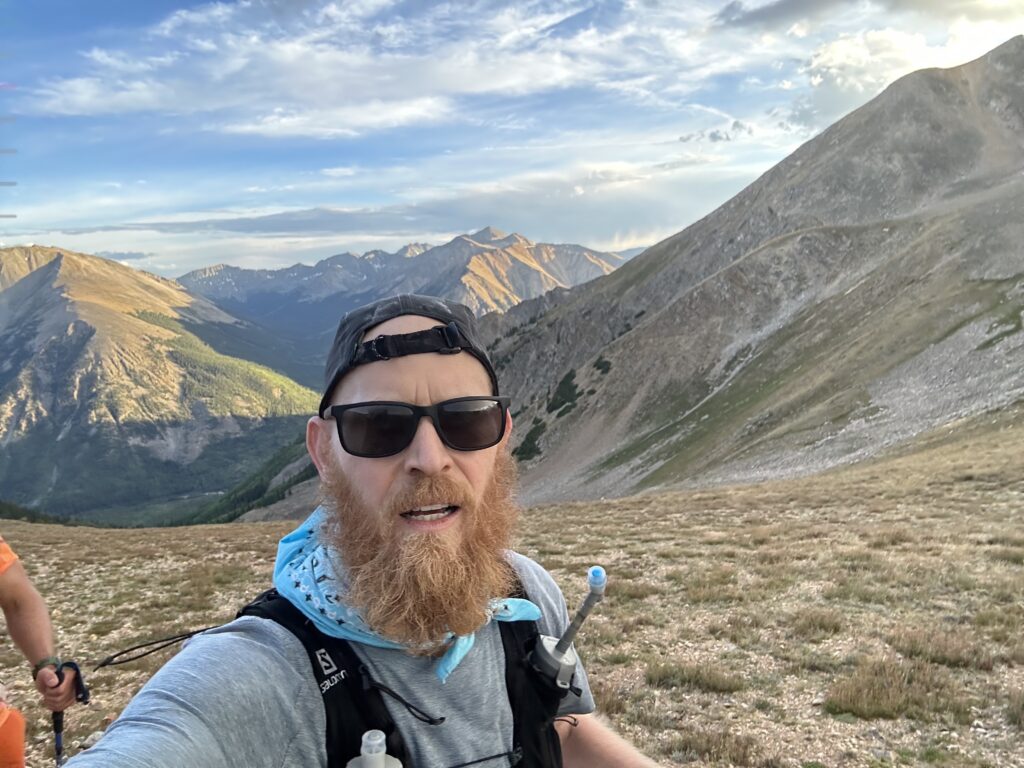
My throat was dry, but I followed Coach’s instructions and swallowed several gels. Next, I dipped my water bottle in the alpine stream and drank some of the best water I have ever tasted in my life before mixing up Hoist and refilling all of my bottles. In what felt like 10 seconds, the five-minute timer went off. I struggled to my feet and started to slowly, but steadily climb. The mountain peak felt elusive and impossible to achieve. However, eventually the progress began to pay off and I could see how far I had come. This was encouraging. Even above treeline, this climb felt like it would never end.
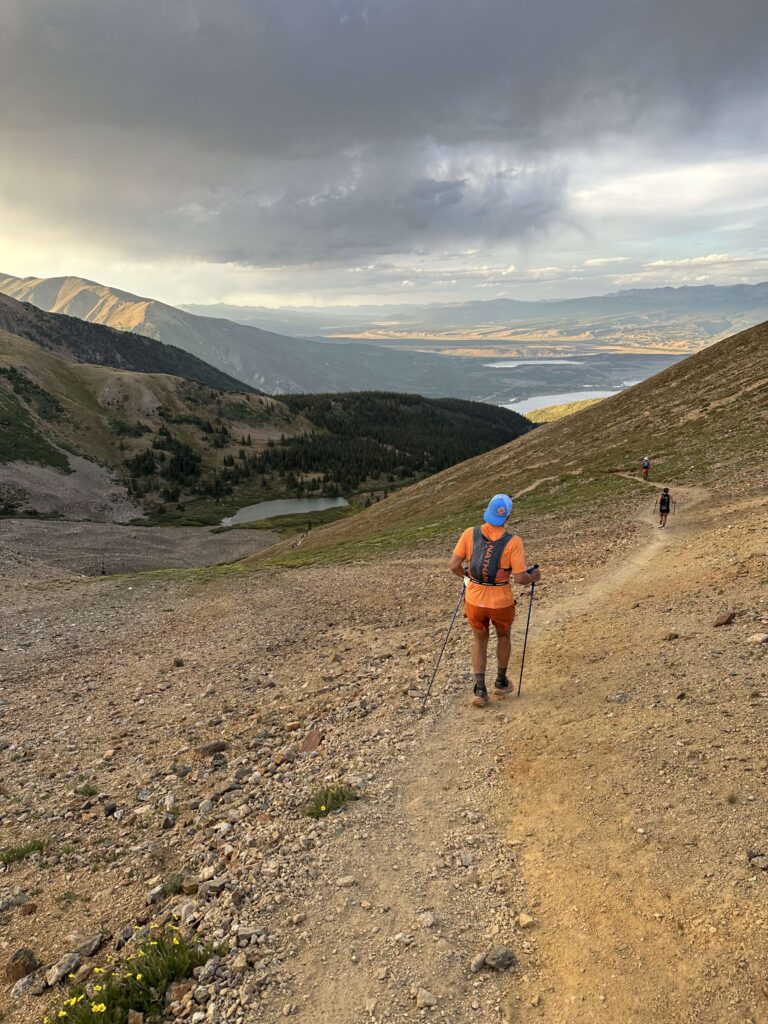
I had never intended on being up here this long! I had made it to Hope Pass a second time though. In the distance, the sun was beginning to set. I knew I must hurry! It was about 7:15 pm and I had to be out of Twin Lakes (far from the top of this mountain) in less than three hours or my race was done. With my headlamp on and sunlight waning, I jogged down the trail, across the river, and eventually through the meadow to where CJ and John Harrison were waiting. I was 62.5 miles into the race and from this point forward the rules allowed me to have a pacer!
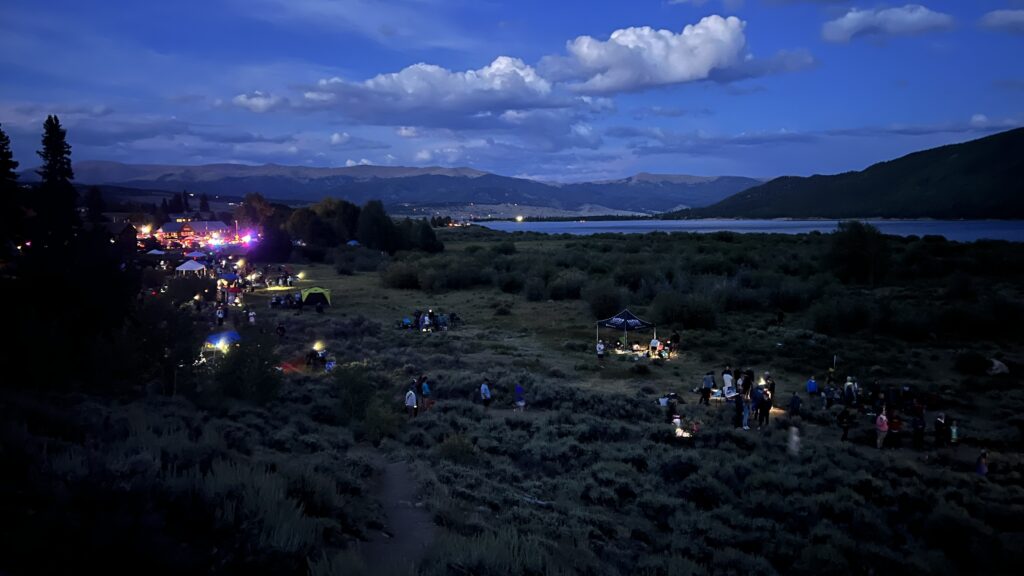
I was beyond excited about the pacers and adding to the excitement was that this break in Twin Lakes (inbound) was the only one of the whole race that we had planned for 10 minutes. After almost 150,000 steps, I sat down in a chair for the first time that day. Without either asking or expecting, John and CJ began massaging me, Catherine washed my feet and changed my shoes, and John Harrison fed me.
This is a great time to talk about the importance of a sacrificial crew. My crew did not know when I would make it back, but waited patiently without complaining. They didn’t know that I would be nauseous and had just thrown up nearly two dozen times, but they had a plethora of calorie choices available. They anticipated every need and not only had the item there, but also had it ready to go and packed in my next pack. In order to have everything, they hauled gear, a cooler, and multiple duffel bags all around Colorado.
We ended up taking closer to 15 minutes, but I was able to get a third of a hamburger down along with some pineapple and some Hoist. Even though this took way longer than I was hoping, I had made it. At this point in the race, a good portion of runners have already been awarded a DNF (Did Not Finish) status due to medical disqualification, timing out, or quitting due to some legitimate reason. I’m still rocking and rolling! I know that statistically and on paper I have made it through the hardest part of the race. The key to finishing the 100 miles at this point is a combination of steady progress and humility. There are still almost 40 miles to go and lots of uphill – finishing is far from certain.
John Stock, a friend of mine and pacer, had an insane energy level. This energy was contagious and exactly what I needed as we trotted out of Twin Lakes ahead of the cutoff time. We take the steep initial trail out of Twin Lakes followed by a long (read miles) steady gradient out of Twin Lakes up Mount Elbert. During the climb, he was a mule for me (allowed by race rules) selflessly carrying my hydration pack and nutrition essentials. Most importantly, he was a constant voice of encouragement and affirmation. His wisdom to know when to point out a dropoff, say something wacky to make me laugh, ponder the meaning of the universe, or just cruise along in silence was exactly what I needed.
Eventually, we popped out of the woods at the Mount Elbert aid station, which they had finally set up (it was missing earlier). In the darkness, the temperatures were cool and we kept cruising. We made pretty good time and got to Half Pipe (71 miles) before too long. We both topped off on nutrition and liquids and kept moving. The name of the game is don’t stop moving and John was perfect at this!

A few miles down the trail from Half Pipe is an unofficial aid station. As we were running into this spot, I felt like I was hallucinating. In front of me was CJ, but I was hearing my last name called loudly at me from somewhere else. “ANGOTTI, ANGOTTI, OVER HERE!” When I looked to my right, I saw my good friends Steve S. and Ryan D. standing there. Even though I doubt it showed on my face, this was so exciting to me. These good friends had flown in to keep me going. No way I was going to let them and my family down! John and I pushed quickly out of there and headed to Outward Bound – it felt like an eternity since I had seen everyone here on my way out yesterday morning.
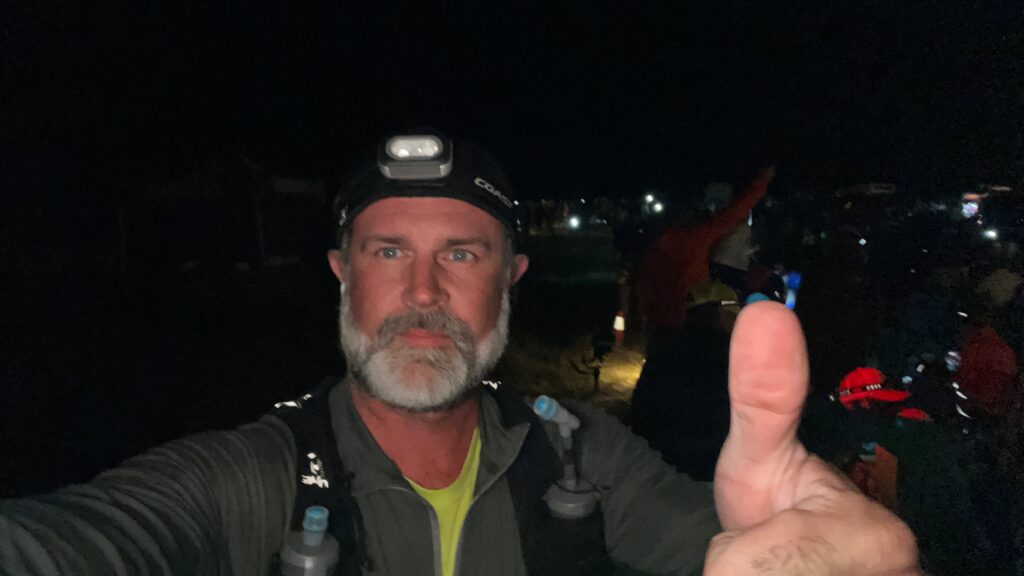
Although it was the middle of the night, I was getting pretty stoked. I had traded out John S for CJ and he was going to pace me over to May Queen. I knew already that I was going to finish, but intellectually I was trying to approach this section with humility. It was the last section that could break me – the last big climb.
A few miles after CJ and I headed out of Outward Bound (inbound), we were at the base of the daunting last climb. I remembered a webinar where an insanely talented runner recounted how this climb 80 miles in broke him. Thanks to his webinar wisdom and having seen it a few times in the day now, I knew exactly what I was dealing with – a soul-breaking climb.
The path to the last major summit (Sugarloaf Pass) is not easy and will gain about 1,500 feet. In the dark, CJ and I could see vomit all over the trail from runners that had either pushed through or been DNF casualties. Up ahead, the summit we could see was not actually the top – one of the psychological challenges with this climb is there are four false summits on Powerline. I don’t remember much on this section to be honest other than we pushed as hard as we could. My body felt broken, but I knew we were going to make it.
At one point, CJ asked what I wanted to talk about. My answer? I told him to just talk and keep me entertained, but between the lack of oxygen, fatigue, and my sore throat (been breathing dust in well over 24 hours) that I couldn’t talk. He handled it like a champ and he and I bonded as he told me stories about his Dad (now deceased) and filled the silence. We even experienced a hallucination-like area of the mountain (called Space Station) at the peak of Powerline – I’ll never forget that climb together.
After Space Station, we started our descent. I remember gazing at sky filled with stars and feeling incredibly alive and grateful. What a feeling! There were even several shooting stars and I was grateful to have such a good friend with me for this experience.
The Colorado Trail, which seemed both runnable and technical on the way out, felt like walking on banana peels on the way in. Without trekking poles and CJ pointing treacherous spots out, I would have definitely wiped out. I felt like my brain wasn’t working right, and like my legs were wobbly. Later, my friend Ryan would state that I looked as if I had slammed a fifth of Tequila as I staggered in from this Colorado Trail section. I’m sure CJ felt like he was watching out for a drunk friend as my coordination was simply gone. This section ended at the last official aid station – May Queen inbound.

I switched pacers here and John S helped encourage me and paced me around Turquoise Lake. For the second time in one non-stop race, I got to see the sunrise. As the sun came up, I felt more awake and generally aware – I stopped slipping as much and I was concentrating on making it around the lake to where my son was ready to pace me. Finally, we got to Sugarloaf Dam where Ryan, Steve, Catherine, CJ, and John H (son) were waiting for me.
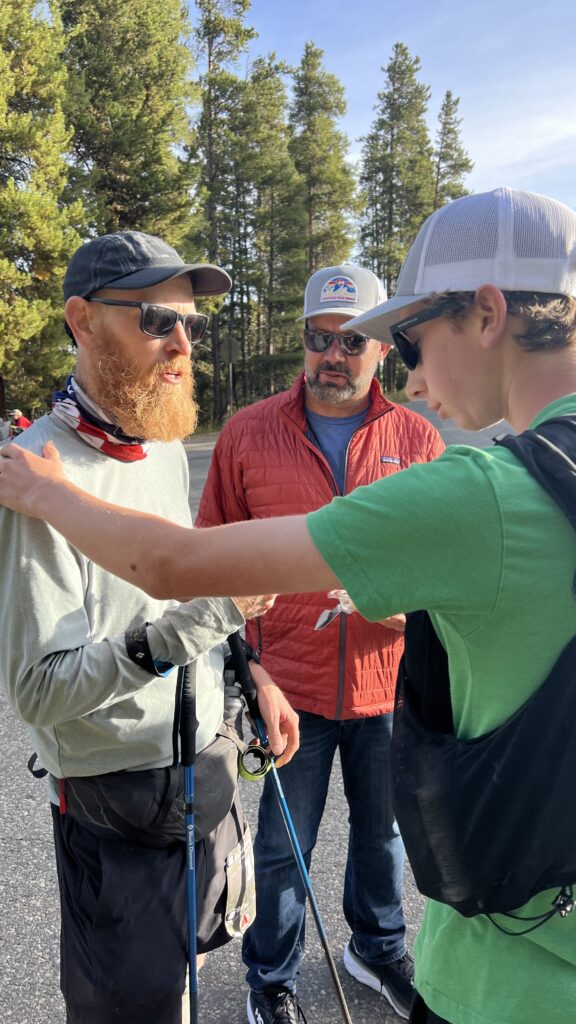
John Harrison and I start down the trail – I know this is the last leg of an important journey and I am so glad he is there. He says exactly the right thing and the right time many times. He keeps me motivated and shows wisdom pacing me that is well beyond his fourteen years.
As we make one of the final turns, my son was asking me a question, but I can’t speak. My throat is too raw from breathing in trail dust for almost 100 miles of running – thankfully the finish line was nearly certain and getting near.
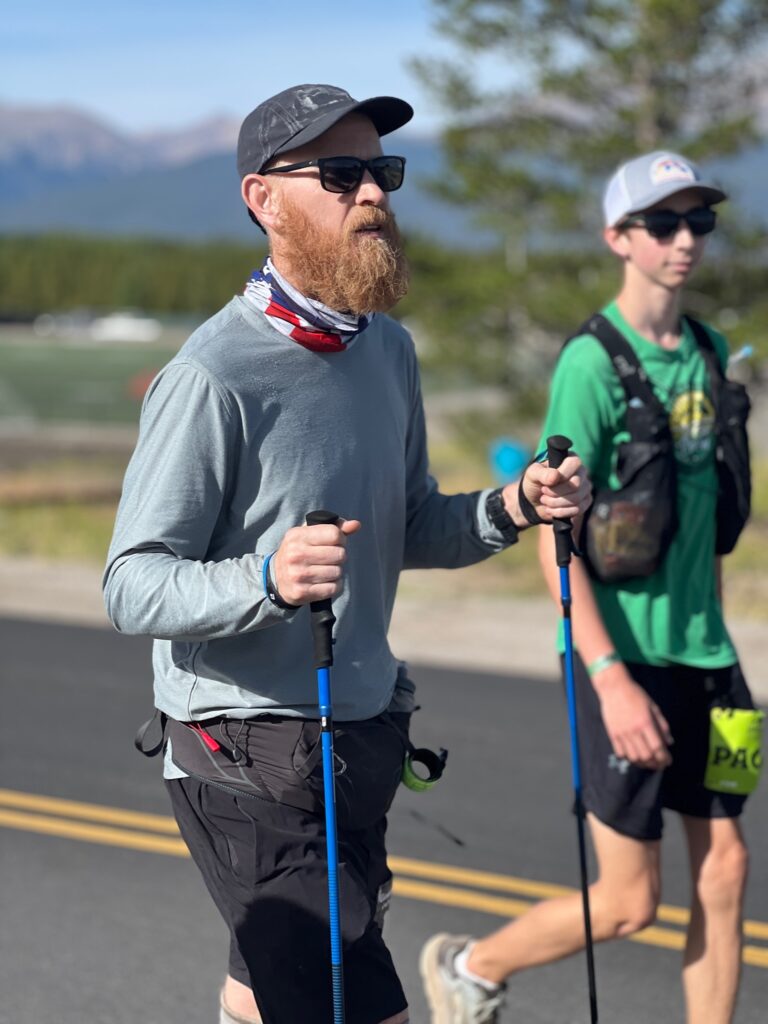
As we exited the trail onto pavement, I could see my pacers (John Stock and CJ Stam), Catherine, and my good friends Steve and Ryan start cheering. Per the race rules, my crew and friends could finish the last mile with me.
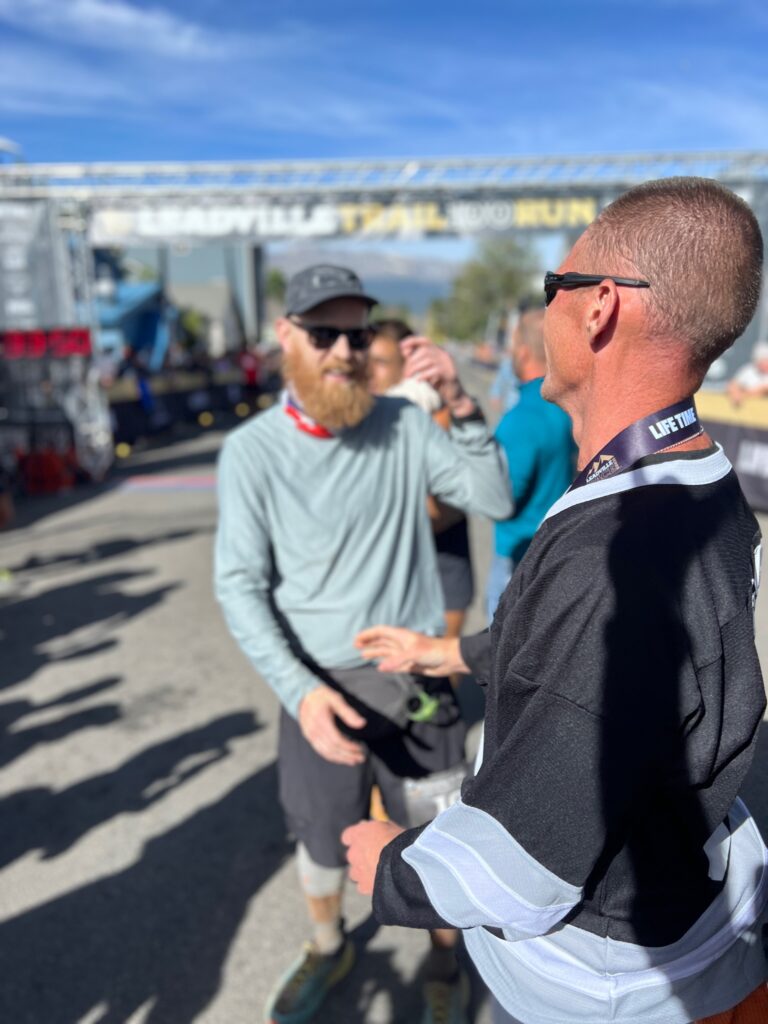
As we crested a hill, the finish line was in sight, but about half a mile away. Although I felt like I was running fast, I knew intellectually and my Garmin watch confirmed that I was actually moving at a slow jog. It was the fastest I could possibly move. Before long, I crossed the finish line.
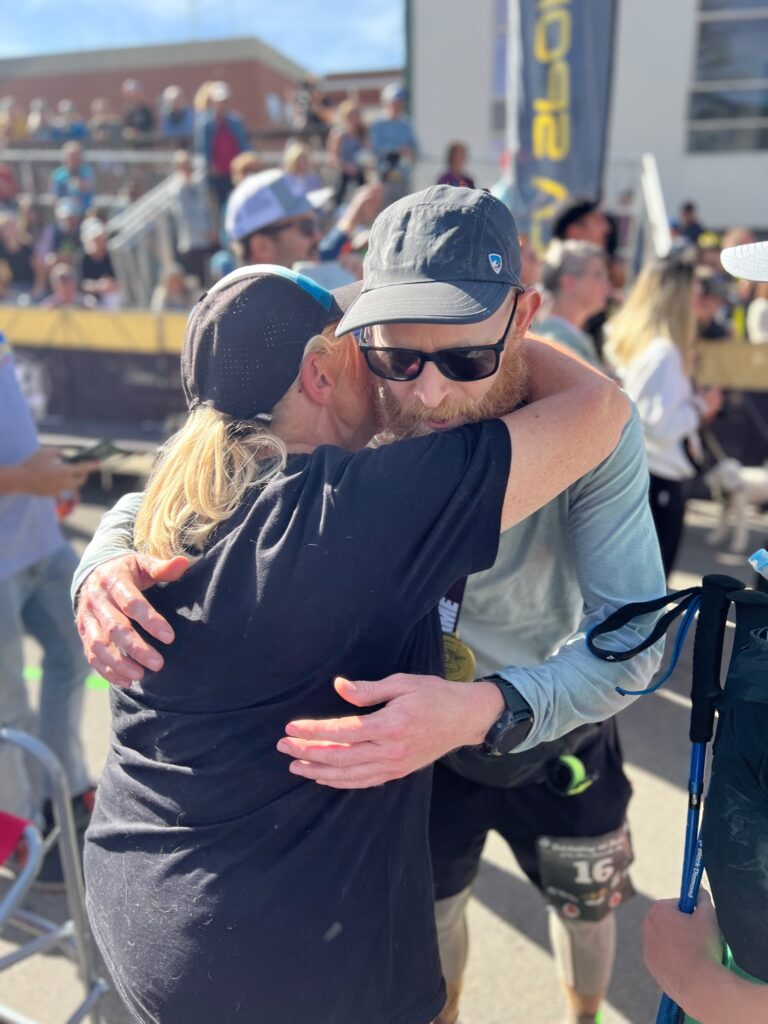
Then, Merilee (race founder), hung a medal around my neck and let me know that I can stop running.

Following the race, multiple people were stunned that I had pushed through that back side of Hope Pass. My coach said, “I saw Angotti ‘dead man crawling’ up from Winfield and sat him under a tree to eat n drink. He is like Lazarus and just rose up and flew in.” Another good friend texted, “Angotti rose like a phoenix from the ashes coming back up The backside of Hope!”
Why did I do this race? I have a fear of being ordinary. I want to be extraordinary.
Extraordinary. For me, for my children. That is my goal.
Extraordinary.

